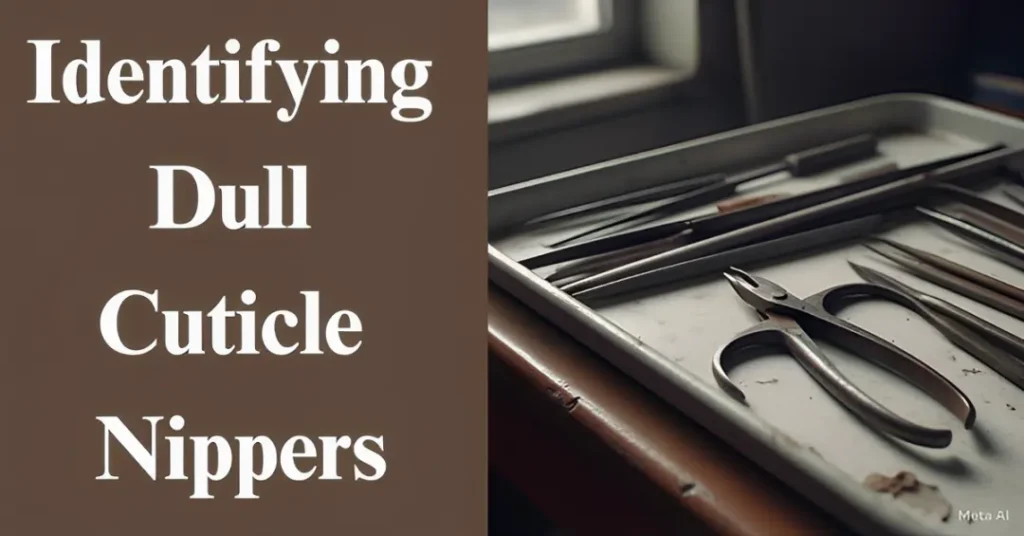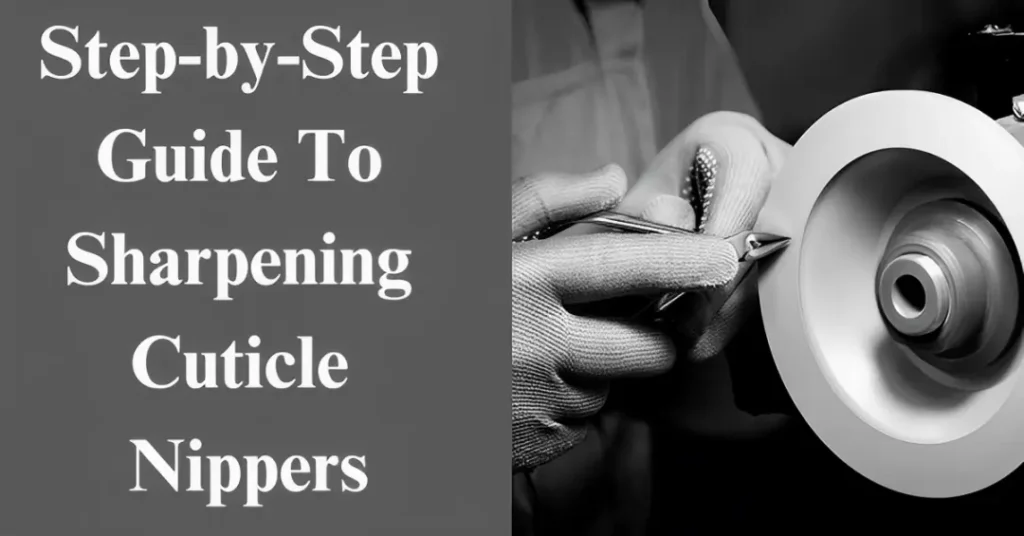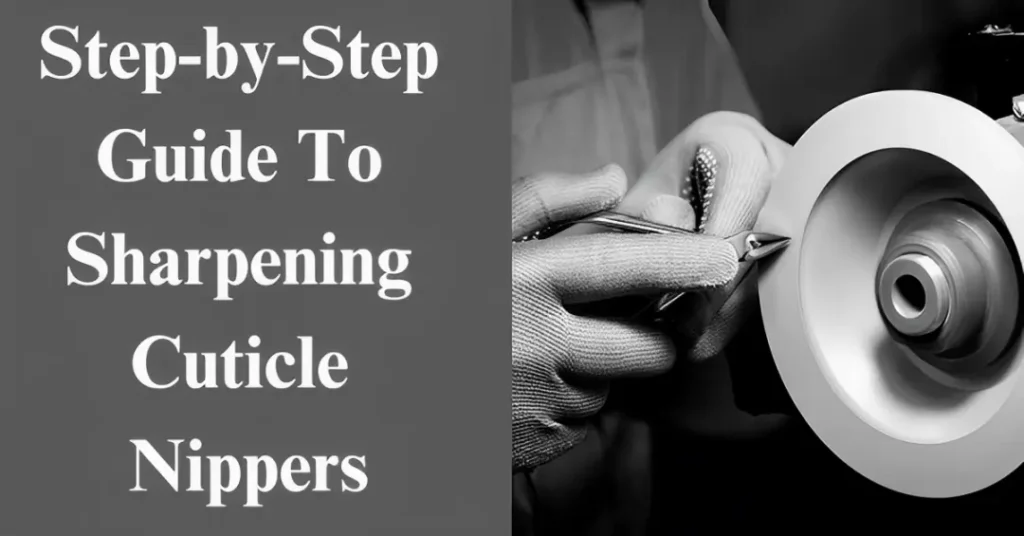Achieving salon-quality nail care starts with properly maintained cuticle nippers, ensuring precise removal of excess cuticle skin and hangnails without causing pain or irritation. Over time, even the best tools can become dull, affecting their effectiveness and efficiency. Keep your grooming routine flawless by learning the right sharpening technique to maintain sharp, safe, and durable nippers for beautiful, healthy nails!

Table of Contents
Why Sharpening Cuticle Nippers is Important

Maintain sharp nippers: Regularly sharpening ensures your cuticle nippers stay sharp and effective, leading to clean cuts and precise removal of excess cuticles and hangnails.
Prevent dull edges: A dull tool can cause snags, tears, and ragged edges, leading to painful discomfort and an increased risk of infection from bacteria and fungi entering the torn entry points of your nails.
Minimize pressure: Sharpening your cuticle nippers reduces pressure on the nails, allowing the tool to glide smoothly and making the process quicker and more comfortable.
Ensure longevity: Regular sharpening extends the life of your nippers, preventing replacements and saving money.
Achieve professional results: Proper maintenance allows for precision in trimming and removing cuticles, giving you professional-looking nails at home.
As someone who’s maintained a sharp tool for years, I can confidently say that sharpening your nippers has made my DIY manicures significantly smoother, avoiding any pain or discomfort while enhancing hygiene and ensuring longevity.
Identifying Dull Cuticle Nippers

- Inspect the blades for visible damage, such as nicks or chips.
- Check for signs of rough, jagged edges that prevent a smooth and clean cut.
- If you notice tugging or pulling when cutting the cuticle, it’s likely a sign that the nippers are dull.
- Pay attention to the pressure needed to remove small pieces of cuticle or hangnails excessive force often signals blades losing their efficiency.
- Observe if you need to make multiple snips to cut through the same area, as this will compromise the performance and longevity of the nippers.
- When cutting, if it feels like the tool isn’t gliding smoothly, the blades might be too dull to achieve a clean and precise cut.
As a nail care enthusiast, I’ve found that dull nippers can lead to uncomfortable tugging and tearing of the skin, causing unnecessary discomfort. Regularly checking for these signs and sharpening early on saves you from more serious issues and ensures efficiency and longevity. I’ve had my cuticle nippers for years, but proper care and early detection of dullness have kept them in top shape, saving both time and money.
Tools and Materials for Sharpening

To sharpen your cuticle nippers effectively, follow these steps:
- Inspect the blades for dullness by checking for rough, jagged edges or tugging when cutting. If you notice tearing or discomfort, it’s time to sharpen.
- Select a fine-grit sharpening stone such as a water stone or oil stone. Apply a small amount of honing oil or water for lubrication.
- Hold the nippers at a slight angle and gently move them across the stone, maintaining pressure and a smooth, even motion to avoid chips or nicks.
- Inspect the sharpness frequently using a magnifying glass to ensure you’re achieving clean, precise cuts without tearing the skin.
- After sharpening, use a soft cloth or chamois to wipe away any metal filings and debris from the nippers.
- Clean the blades thoroughly with a toothbrush to remove any remaining particles, ensuring proper hygiene.
- Always wear safety glasses to protect your eyes from fragments and shavings during the sharpening process.
- Store your nippers safely and maintain them regularly to extend their longevity and ensure they are always ready for your next manicure.
From personal experience, I’ve found that following these steps with the right tools and lubrication always leads to sharp, smooth cuts, significantly improving my overall nail care routine.
Step-by-Step Guide to Sharpening Cuticle Nippers

Sharpening cuticle nippers is a delicate process that requires precision and patience. Here’s a step-by-step guide:
- Clean your nippers by soaking them in warm, soapy water. Use a toothbrush to scrub off any dirt, debris, or residue. Dry the nippers with a soft cloth to avoid any water spots.
- Prepare your sharpening stone by applying a few drops of oil for lubrication. This helps in maintaining the sharpness of the blades and ensures smooth movement during the sharpening process.
- Place the nippers on the stone. Use a magnifying glass to closely examine the bevel of the blades. Position the nippers in the dominant hand and focus on sharpening the outer edge first.
- Sharpen with flat strokes, applying even pressure. Take care not to apply too much pressure to avoid damage. Sharpening should be done using a gentle sweeping motion to avoid nicks or burrs on the blade.
- Alternate between sharpening the inner and outer edges to refine the blade. Regularly check for sharpness by inspecting the blade under a magnifying glass.
- Once the edge feels sharp, use a leather block or strop to polish and strop the blade, ensuring a razor-sharp finish.
- Wipe off any filings and lubricate the joint with a little more oil to ensure smooth movement of the nippers.
In my personal experience, I’ve found that stropping the nippers on leather after sharpening is a game-changer. It adds that final touch, leaving them ready for precise and clean cuts every time. This step really extends the longevity of your nippers, saving you money on replacements.
Tips for Maintaining Sharp Cuticle Nippers

- Clean your nippers after each use by washing them in warm, soapy water and scrubbing away dirt with a brush.
- Dry them thoroughly with a soft cloth to prevent any rust or water damage.
- Store your cuticle nippers in a protective case or pouch to protect the blades from accidental damage.
- Avoid dropping your nippers as it may affect the alignment of the blades, leading to inefficient cutting.
- Use your nippers for their intended purpose, such as trimming cuticles and hangnails, to ensure they remain sharp.
- Sharpen your nippers regularly to keep them in top shape and avoid a dull cutting edge.
- Always maintain them with gentle care, avoiding excessively heavy use to prolong their lifespan.
In my personal experience, proper maintenance has helped me maintain my nippers’ sharpness for a longer time, minimizing the need for constant sharpening or frequent replacements. The way I store and clean them after each use has made a noticeable difference in the overall performance and efficiency, saving me both time and money.
Professional Sharpening Services
When your cuticle nippers become uncomfortable or severely damaged, professional sharpening services are a great solution. Nail salons and beauty supply stores offer specialized services with the right equipment to restore the original sharpness of your nippers, ensuring optimal performance. From my experience, these services offer the best results, saving time and effort while maintaining tool quality.
Conclusion
To maintain the sharpness and efficiency of your cuticle nippers, it’s essential to regularly sharpen them, inspect for dullness, and clean them after every use. Professional sharpening services can be incredibly helpful, especially when your nippers become uncomfortable or severely damaged, as they can restore the original sharpness and ensure optimal performance.
FAQ,s
What is the best way to sharpen nail clippers?
To maintain and sharpen your cuticle nippers, it’s crucial to use a stropping stone for consistent honing. Holding the nippers at a consistent angle against the stone and executing smooth strokes ensures both blades achieve uniform sharpness. A few passes on each side should leave them sufficiently sharp for a clean cut, without exposing the nail clippers to undue wear.
How do you take care of a cuticle nipper?
To clean your cuticle nipper, simply submerge it in soapy water for a couple of minutes to help loosen any buildup. Then, gently scrub the surfaces, especially the crevices, to remove dirt that tends to accumulate. Afterward, rinse with running water to remove soap and debris, and finally, pat dry with a clean cloth.
